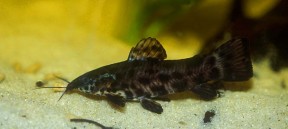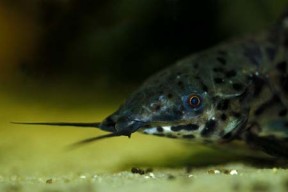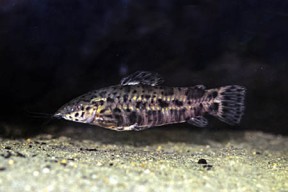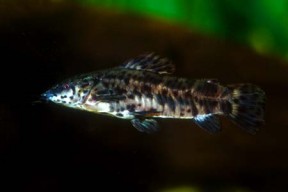Megalechis thoracata
Spotted Hoplo
Classification
Callicthyidae. subfamily: Callichthyinae
Distribution
Widespread across northern South America
Habitat
Primarily still waters
Maximum Standard Length
6″ (15cm)
Aquarium SizeTop ↑
48″ x 15″ x 12″ (120cm x 37.5cm x 30cm) – 140 litres
Maintenance
The hoplo is not a particularly shy catfish but will still appreciate some cover in the form of rocks, plants and bogwood. Water flow should be slow or still, although the fish will adapt to stronger conditions. Sandy or fine gravel should be provided as the fish enjoys rooting through the substrate in search of food. Lighting is not critical and should be tailored to suit the plants used.
Water Conditions
Temperature: 64 – 82°F (18 – 28°C)
pH: 6.0 – 8.0
Hardness: Up to 20°H
Diet
Accepts most commercially available foods. Live or frozen foods should also form part of the diet.
Behaviour and CompatibilityTop ↑
Peaceful community fish, can be kept with smaller fish such as tetras and barbs. The adaptable and hardy nature of the hoplo means that they can be kept in almost any setup, including with larger more aggressive species such as Central American cichlids.
Sexual Dimorphism
In the male, the leading ray of the pectoral fins is thicker and orangey / yellow in colour. The male also develops a more colourful belly when inbreeding condition.
Reproduction
Bubblenester. The male builds the nest and it is helpful if floating plants are provided to stengthen this. The breeding tank should have very gentle filtration to avoid surface agitation which may destroy the nest.The female can be removed after spawning as the male will guard the nest and may show aggression towards the female.
Eggs hatch in around 48 hours and the fry are free swimming 3 – 4 days after this. It is a good idea to remove the male from the breeding tank at this point as, on occasion, they have been known to eat the fry. Fry should be fed newly hatched brineshrimp initally and progressed onto fry foods and crushed flake and pellets as they grow.
Breeding is fairly easy. As with most callicthyidae family, reluctant fish can be induced to spawn with a water change of cooler water.
NotesTop ↑
Still widely referred to as hoplosternum thoracatum the hoplo cat is a popular and hardy fish. These fish have the ability to breathe atmospheric air by gulping down mouthfuls of air and the oxygen is then absorbed into the bloodstream through the intestine. This allows the fish to endure poor conditions in the wild but it can still be observed exhibiting this behaviour in captivity.
The hoplo is also eaten as a food fish in parts of South America.






June 12th, 2019 at 3:19 pm
I had two spotted hoplos in a 150 g tank with sand/dirt substrate. They were really fun fish: Hardy, active, peaceful, intelligent, big and exotic looking. However, they almost ruined the tank with their constant, nocturnal digging. I would arrive in the morning to find the plants and hardscape covered in silt.
I would love to keep these again, but only in a gravel or straight-sand substrate. Don’t put the in a dirted tank!